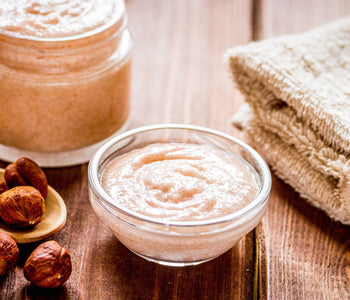Medically reviewed by Minimalist Health Specialist - Written by Arpita Singh (Beauty Expert) on 30th Oct 2020
The Role of Amino Acids in Skincare

Amino acids are the building blocks of various body structures and fluids. Pretty sure you have heard this statement more often. We are starting from the school-level science books to the latest magazines and health columns.
Well, it is an absolute fact. Millions of cells and nerves, and the vital body processes - all have amino acids to play a significant role in their making-up (composition) or the functions they perform.
Peptides and proteins may sound more familiar to you. They are both related to amino acids—a little details on how exactly.
Peptides are made up of amino acids, usually in the range of 2 - 50. At the same time, many peptides link together and form the involved proteins. The latter have longer chains of amino acids present, and even chains are more in number.
More on amino acids and its two basic types!
Skin is the largest organ of our body. Amino acids remain ingrained in the tissues that constitute the different layers of skin. These can be categorized into two basic types.
• Non-essential amino acids
Firstly, you should not take the term for its literal meaning. This group of amino acids is also essential for your body. However, the name "non-essential" indicates that you need not obtain these amino acids from outside sources. They are well produced in your body and in sufficient quantities.
These acids are also called the conditional amino acids, as your body prepares them only under specific conditions such as stress, illness, etc.
There are 11 non-essential amino acids in total, and they being: alanine, arginine, asparagine, aspartic acid, cysteine, glutamic acid, glutamine, glycine, proline, serine, and tyrosine.
• Essential amino acids
This group of acids has to be obtained through the diet mainly. Any supplementary course may boost the intake of acids. But, the latter seeks prior recommendations to a health care expert.
The body does not form the essential amino acids on its own. So, it falls on your shoulders to get all these nutrients from food. They can be derived from animal sources, including meat, fish, and their byproducts such as milk and eggs. If you are vegan, you can gain the acids from nuts, beans, soy (soy milk), tofu, legumes, grains (buckwheat, quinoa).
There are nine essential amino acids in total, and they being: histidine, isoleucine, leucine, lysine, methionine, phenylalanine, threonine, tryptophan, and valine.
How amino acids help your skin to function smoothly?
1) Act as the natural moisturizing factors (NMFs) for the skin.
You may ask, what are NMFs, though?
They are the naturally present compounds in your skin and keep its outermost layer (stratum corneum) well-hydrated. An NMF is roughly composed of 42% amino acids and PCA (again, a compound of amino acid origin).
They help the cells in the stratum corneum retain moisture, which, in turn, affects the overall moisture content of the skin.
When your skin has the right balance of NMFs and epidermal lipids, the cells in your stratum corneum are tightly arranged. It gives a healthy appearance to your skin.
2) Coordinate with the body's water transport system, aquaporins.
Aquaporins are membrane proteins that serve as channels and regulate water flow in and out of the cells.
Amino acids do an all-time partnership with the aquaporins and facilitate smooth water conduction among the skin cells.
3) Protect your skin against UV damage.
They work as antioxidants and hunt down the free radicals in the body. Free radicals are the reactive oxygen atoms, which, to gain stability, try to steal electrons from the body cells, causing damage to the DNA.
Some of the amino acids, one being glutathione, is an antioxidant produced by cells in the body.
4) Reduce the wrinkles and tighten your skin's surface.
They prevent and diminish the early signs of aging.
5) Condition your skin to become supple and resilient.
Topical products containing amino acids fortify the natural defense mechanism of your skin and improve its texture.
Note:
Synthetic amino acids provide better hydration than the ones obtained from natural sources, i.e., from plants and animals
6) Help to maintain the natural pH levels of the skin.
So that you know, pure amino acids are hypoallergenic.
Now, the skin is naturally acidic and has a pH of 5 to 6. The use of soaps, detergents, and hand washes in daily life can increase your skin's alkalinity. Amino acids neutralize the acid-base problems of your skin and keep it soft.
7) Build tissues in your skin.
Collagen, elastin, fibrinogen is all protein compounds that form the structural base of your skin. Their proper synthesis, growth, and replacement are vital for your skin to thrive.
Amino acids play a vital/significant role in collagen production and, thereby, works to preserve your skin's elasticity.
8) Promote healing.
They repair and replace the damaged proteins in your skin. Mostly, they are known to boost the process of wound healing and closure.
9) Prevent muscle protein breakdown.
If your body suffers from a deficiency of amino acids, the cells start breaking down the muscle proteins to meet their needs. It causes the thinning of muscle strands and harms the skin. It loses its firmness and gets weak.
An adequate supply of amino acids is essential for the body as well as the skin. Serine, an amino acid, is responsible for the formation of cell membranes.
10) Ensures some normal processes of the body to be carried out quickly.
They help in the smooth penetration of ingredients introduced to the skin.
Amino acids even aid in absorbing certain nutrients, which have direct metabolic effects on the skin.
Each amino acid plays its part.
Let us take a closer look at some of them.
Both essential & non-essential amino acids are equally contributing to the skin. Experimental studies have established the facts for some and the vast benefits they offer.
1) Arginine and Methionine
These two amino acids form a compound known as creatine (which naturally occurs in the muscles, brain, immune cells, etc.)
Now, creatine serves the skin in several ways. It helps the skin to perform its regular functions effectively. It even stimulates the cells to make collagen and elastin.
Studies indicate that the cells which are supplied with creatine are capable of repairing damaged DNA. It can protect the cells by surrounding them with a thin film of water, thereby allowing the skin to replenish the lost moisture.
It protects the connective tissues from damage and raises the thickness of the skin. You should know that collagen increases the ability of water retention in the skin.
Thus, creatine helps your skin to look young and fresh.
Interesting fact:
Arginine and methionine combine to form the peptide, Carnitine. It is the "fat burner" because it transferred the fatty acids to be used as a fuel and burned off to release energy.
2) Glutamine
Famously referred to as the "fountain of youth from within," it is essential to synthesize proteins and regeneration of tissues in the body (including the skin).
However, as you age, glutamine is produced in lesser quantities. They are enough to befit the requirements. What follows is the body obtaining proteins from muscles and their subsequent thinning. This accelerates the process of aging.
Coffee, nicotine, and meat consumption can lead to hyperacidity in the body and affect the skin too. Glutamine neutralizes the acids and establishes a balance between acids and bases.
3) Lysine
Although there is very little evidence showing up, a few theories suggest that lysine can treat inflammatory acne. It may also help with cold sores. Most importantly, it helps you build more collagen in the skin. Often, these can be taken in the form of supplements.
It depends on Vitamin B, C, and iron for its absorption. If your body doesn't have enough of these nutrients, it may lack lysine.
If your body fails to attain the necessary lysine levels in the body, it could lead to protein deficiencies and even anxiety.
4) Histidine
It works mainly as an antioxidant, neutralizing the free radicals formed in the body due to UV radiation and other external factors. One particular study (2008) looks into its novel anti-fungal properties and how it can ward off infections.
5) Leucine, Proline, and Glycine
Leucine, when used in conjunction with proline and glycine, can improve the wrinkles on your skin. The trio also works on the crow's feet, or the creases that appear around your eyes.
6) Threonine
It is indispensable for the formation of collagen and elastin.
Research backs the theories for amino acids.
According to a study on protein metabolism (2011-12), "oral administration of glutamine and proline are important for restoring dermal collagen protein, which is damaged by the UV radiations."
"Topical application of dressings with amino acids improves cutaneous wound healing and calls upon its early closure. Also, with increased fibroblast function, collagen synthesis, and reduced inflammation..." states a particular research paper.
A randomized study conducted on 42 subjects (stretching between November 2014 to February 2015) compares the effects of an amino acid moisturizing cream and a desonide cream. The clinical trial (demanding the two-times application of the chosen product regularly) concludes that both the ingredients considerably reduced mild to moderate atopic dermatitis (i.e., eczema).
What do the dermatologists have to say about amino acids?
Almost all appreciate the fact that amino acids are excellent moisturizers. They confirm amino acids can give you the synthesis in the body. Yet, they expect extensive research on the same.
There are many dermatologists who out rightly reject the theories, calling them preliminary observations.
They insist that the brands cite minor studies and make false claims on amino acids' benefits—they advise us to remain aware of the placebos and touts.
Topical use of amino acids.
They are available in various OTC products such as facial moisturizers, eye creams, face cleansers, body lotions, etc.
It is advised that you use them at night as the basal body temperature is the highest then, and it ensures better penetration of the ingredient.
Results take some time to show up. But the specific intervals depend on the amino acid products you pick and how you use them along with the other ingredients.
Minimalist tip:
In combination with glycerin, ceramides, peptides, or hyaluronic acid, you can reap huge benefits out of the amino acids.
Amino acid toxicity is a rare episode. No severe side effects on the skin either. In case you get a rash or face any discomfort, report it to your dermatologist.
The Bottom Line
Once you turn 40, the process of cell division slows down. There is a delay caused by the replacement of cells. Newer ones required for having a supple and firm skin, decrease in number. It has also been estimated that after 25, the supporting fibers (collagen and elastin) - their growth and synthesis lessen. Aging becomes a significant concern for you.
But an optimum intake of amino acids can retard the onset of aging symptoms. Food is a chief source of all amino acids. You must be familiar with skin is a direct reflection of your metabolism. So, eat well!
Lastly, a small reminder! If you are deficit in any of the major proteins, you may face health issues. As it will foil or affect the production of other proteins. If you wish to incorporate amino acids in your daily routine, seek advice from an expert (especially if you want the supplements).





